Build This Beautiful 4×4 Patio Set That Lasts for Decades
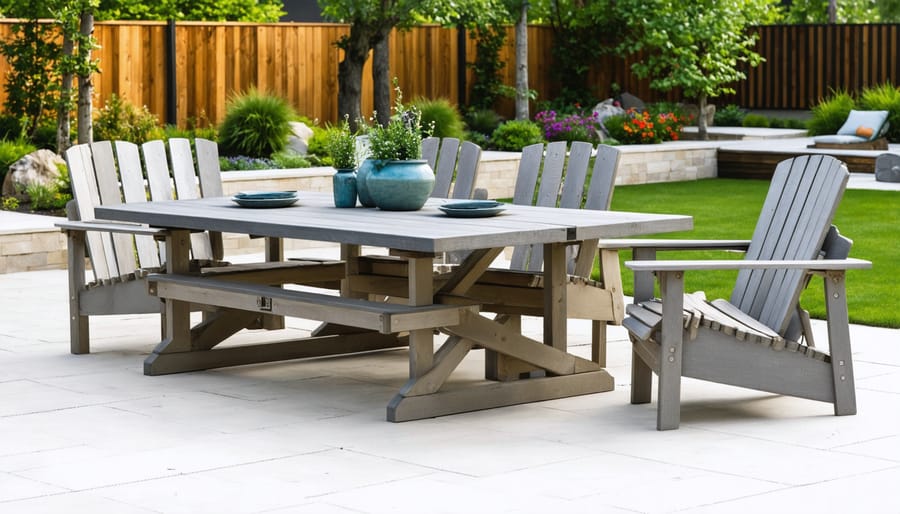
Transform your backyard into a personalized outdoor oasis with rugged 4×4 lumber projects that combine durability with timeless design. Building your own sustainable outdoor furniture not only saves money but creates lasting pieces that withstand years of weather exposure. These construction-grade timber plans deliver professional results using basic power tools and readily available materials from any home improvement store.
Start with straightforward projects like robust benches and picnic tables, perfect for developing essential woodworking skills while creating functional outdoor pieces. The thick dimensions of 4×4 posts provide exceptional stability and strength, eliminating the wobble common in lighter furniture designs. Each project features weatherproof joinery techniques that prevent water damage and resist rot, ensuring your outdoor creations maintain their integrity through seasonal changes.
Master the fundamentals of mortise and tenon joints, lap joints, and proper hardware selection to build everything from elegant garden chairs to sophisticated dining sets. These time-tested construction methods, combined with pressure-treated lumber, create furniture that rivals commercial options at a fraction of the cost. Whether you’re a weekend warrior or seasoned craftsperson, these plans offer clear, step-by-step guidance for building heirloom-quality pieces that enhance your outdoor living space.
Why 4×4 Lumber Makes Perfect Sustainable Outdoor Furniture
Sustainability Features
When building your outdoor furniture, choosing sustainable materials isn’t just good for the planet—it’s an investment in long-lasting quality. We recommend using FSC-certified pressure-treated lumber, which comes from responsibly managed forests and offers excellent durability. Cedar and redwood from certified sources are fantastic alternatives, naturally resistant to decay and insects without requiring harsh chemical treatments.
Consider exploring reclaimed 4×4 posts from local salvage yards—they often have character and history while keeping materials out of landfills. For protection, opt for eco-friendly sealants and stains that are low-VOC (Volatile Organic Compounds) and water-based. These treatments provide excellent weather protection while being safer for your family and the environment.
Creating eco-friendly patio designs starts with smart material choices. Look for suppliers who participate in tree replanting programs, and always verify the sustainability certifications of your wood sources. When possible, choose locally sourced materials to reduce transportation emissions and support your community’s economy.
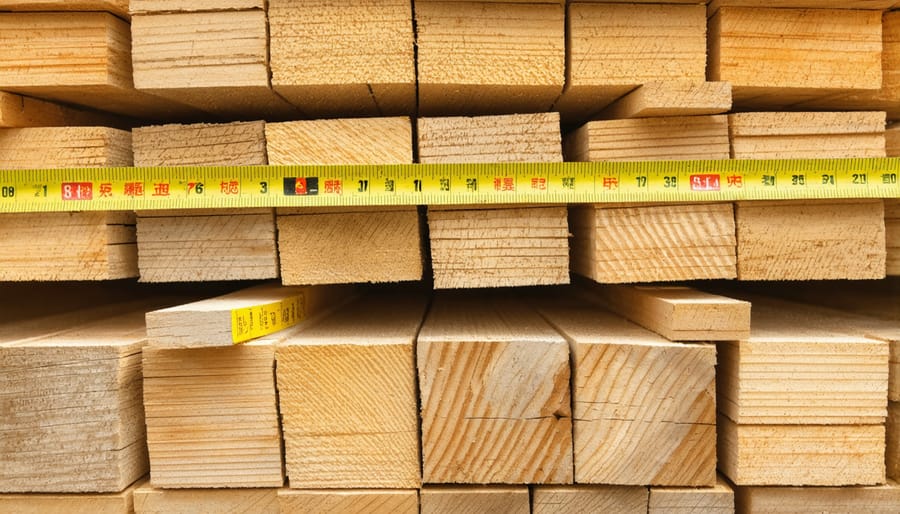
Weather Resistance Benefits
When building outdoor furniture with 4×4 lumber, you’re already starting with a significant advantage in terms of weather resistance. These robust posts naturally stand up better to the elements than thinner lumber options. To maximize durability, we recommend using pressure-treated 4x4s, which come pre-treated with preservatives that guard against moisture, insects, and decay.
For additional protection, apply a high-quality exterior sealant or wood stain specifically designed for outdoor use. This extra layer helps prevent water absorption and UV damage, which can lead to warping, splitting, or fading over time. Consider using marine-grade hardware and rustproof fasteners to prevent unsightly rust stains and maintain structural integrity.
Proper construction techniques also play a crucial role in weather resistance. Design your furniture with slight angles or gaps to allow water runoff, and elevate the legs slightly off the ground to prevent constant ground contact. With these protective measures in place, your 4×4 outdoor furniture can easily last 10-15 years or more, even when exposed to harsh weather conditions year-round.
Essential Materials and Tools
To build sturdy 4×4 outdoor furniture, you’ll need high-quality materials and reliable tools. Let’s start with the essential materials:
Lumber:
– 4×4 pressure-treated posts (quantity depends on your specific project)
– 2×4 pressure-treated boards for support
– 1×6 or 2×6 boards for seating and surfaces
– Deck screws (3-inch and 2.5-inch)
– Exterior wood glue
For a sustainable option, consider using cedar or cypress instead of pressure-treated lumber. These naturally resistant woods last longer outdoors and are eco-friendlier choices. You might also explore reclaimed lumber from local suppliers for a unique, environmentally conscious approach.
Required Tools:
– Circular saw or miter saw
– Power drill with drill bits
– Impact driver
– Measuring tape
– Speed square
– Pencil
– Level
– Sandpaper (60, 120, and 220 grit)
– Safety equipment (goggles, ear protection, dust mask)
– Saw horses or sturdy work surface
– Clamps (at least 4)
Optional but Recommended:
– Router with roundover bit
– Electric sander
– Kreg jig for pocket holes
– Carpenter’s square
– Wood chisel set
Finishing Materials:
– Exterior wood sealer or stain
– Paint brush or foam applicator
– Clean rags
– Wood filler for any gaps
– Pre-stain wood conditioner
Remember to choose weather-resistant hardware:
– Galvanized or stainless steel screws
– Corner brackets (if needed)
– Heavy-duty hinges (for movable pieces)
– Weather-resistant cushions or padding
Store all materials in a dry place until you’re ready to begin, and ensure your work area is well-ventilated when applying finishes. Quality tools and materials might cost more initially but will save money in the long run through durability and reduced maintenance needs.
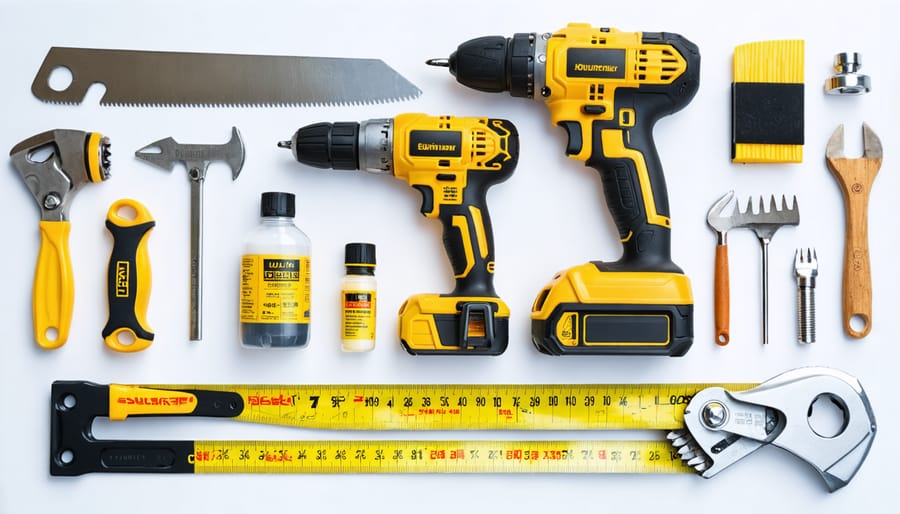
Building Your 4×4 Outdoor Furniture Set
Building the Chair Frame
Begin by laying out your 4×4 posts on a flat surface to create the chair’s basic frame. Cut two pieces at 24 inches for the front and back legs, and two pieces at 22 inches for the seat support. These will form the foundation of your chair. Make sure all cuts are precise and square for proper alignment.
Connect the legs and seat support using exterior-grade carriage bolts, washers, and nuts. Pre-drill holes through the 4x4s to prevent splitting, then secure the joints. The front legs should be perfectly vertical, while the back legs need a 5-degree angle for comfort and stability. Use a speed square to mark these angles accurately.
For the chair back, cut two vertical supports at 30 inches, keeping that same 5-degree angle. Attach these to the rear frame using the carriage bolt method. The backrest will need three horizontal 4×4 pieces cut at 20 inches each. Space them evenly and secure them to the vertical supports using 4-inch deck screws.
The seat requires three 20-inch pieces of 4×4, placed horizontally across the seat support frame. Leave a ½-inch gap between each piece for water drainage. Pre-drill and secure with deck screws through the support frame into the seat pieces.
Finally, add diagonal bracing between the front and back legs using 4×4 cuts at 45-degree angles. These provide crucial stability for your chair. Sand all surfaces thoroughly, paying special attention to corners and edges for comfort. Your chair frame is now ready for finishing touches like weather protection or paint.
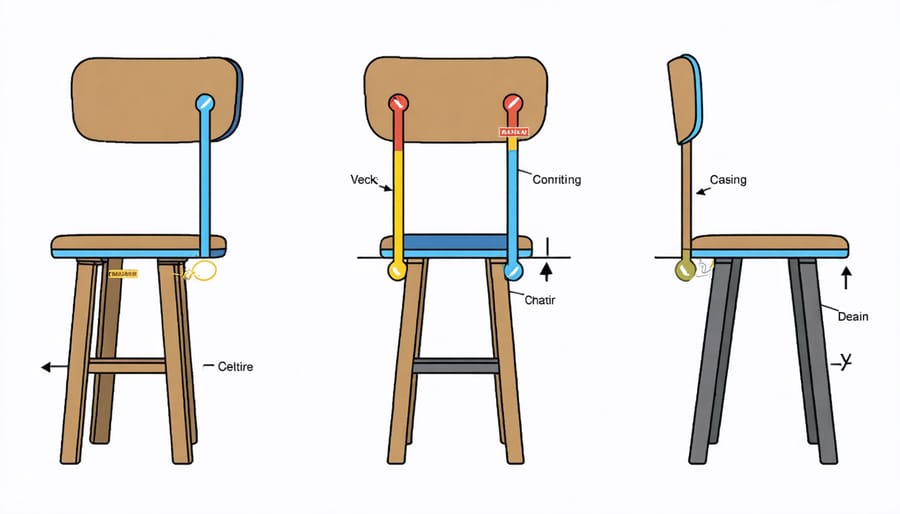
Creating the Table Base
Let’s start building the foundation of your outdoor table by creating a sturdy base. Begin by laying out four 4×4 posts that will serve as your table legs, each cut to 28 inches in length. Sand all surfaces thoroughly to prevent splinters and ensure a smooth finish.
Next, measure and cut two 4×4 pieces for the long side supports, matching the desired length of your table (typically 60 inches for a comfortable six-person setting). For the shorter ends, cut two more 4x4s to 36 inches. These measurements create an ideal rectangular frame for outdoor dining.
Position your table legs at each corner and attach the side supports using 4-inch deck screws. Pre-drill your holes to prevent wood splitting, and ensure each corner is perfectly square using a carpenter’s level. Add a weatherproof wood glue before securing the screws for extra stability.
To reinforce the structure, install diagonal braces between the legs and side supports. Cut 45-degree angles on 2×4 pieces approximately 12 inches long. These braces provide crucial support against lateral movement and will keep your table stable on uneven outdoor surfaces.
For added durability, consider adding middle support beams running parallel to the short ends. Space them evenly, about 20 inches apart, to prevent any sagging in the tabletop. Secure these supports using the same method as the outer frame.
Before moving on to the tabletop, double-check all connections and ensure everything is level. This strong foundation will support your table for years of outdoor enjoyment, standing up to weather and regular use with minimal maintenance required.
Adding Comfort Features
Comfort is key when creating a welcoming outdoor living space, and your 4×4 furniture deserves thoughtful attention to seating comfort. Start by selecting sustainable materials for your cushioning – recycled foam or natural latex make excellent eco-friendly choices. Cut your chosen padding material to size, allowing an extra inch on all sides for proper coverage.
For seat cushions, aim for a thickness of 3-4 inches to provide adequate support while maintaining a proportional look. Create a gentle slope from back to front by tapering the foam slightly – this prevents water pooling and ensures proper posture. When crafting backrests, consider a 2-inch thickness with a subtle curve for ergonomic support.
Weather-resistant fabric is essential for longevity. Consider using solution-dyed acrylic materials like Sunbrella, which resist fading and repel moisture. For an eco-conscious alternative, look into recycled polyester fabrics or organic cotton treated with natural water-repellents. Create simple envelope-style covers that can be easily removed for washing.
Secure your cushions using hidden Velcro strips or ties made from weather-resistant materials. Position these at the corners and center points to prevent shifting. Add drainage holes in the seat base by drilling small openings at regular intervals – this helps prevent moisture buildup and extends the life of both cushions and wooden frame.
For additional comfort, consider incorporating lumbar pillows made from the same weather-resistant materials. These not only provide extra support but also add a decorative touch to your furniture. Remember to store cushions in a dry place during harsh weather conditions to maintain their quality and extend their lifespan.
Eco-Friendly Finishing Touches
When protecting your 4×4 outdoor furniture, choosing environmentally conscious finishes isn’t just good for the planet – it’s great for your health and the longevity of your pieces. Today’s earth-safe finishes offer excellent protection while maintaining the natural beauty of your wooden furniture.
Consider using natural oils like tung or linseed oil, which penetrate deeply into the wood fibers while remaining completely biodegradable. These oils enhance the wood’s natural grain pattern and provide reliable water resistance. For added durability, beeswax-based sealants create a protective barrier that’s both water-resistant and completely natural.
Plant-based polyurethanes are another excellent option, offering superior protection without harmful VOCs (Volatile Organic Compounds). These modern formulations provide the same level of protection as traditional finishes but are safer for your family and the environment.
For color treatments, look for water-based stains containing natural pigments. These allow the wood to breathe while adding beautiful, lasting color. Many manufacturers now offer eco-certified options that meet strict environmental standards while delivering professional-grade results.
Remember to reapply your chosen finish annually or as needed, particularly in areas with harsh weather conditions. Before application, always sand your furniture lightly and clean thoroughly with natural cleaners to ensure proper adhesion. This maintenance routine will keep your outdoor furniture looking fresh while maintaining its eco-friendly integrity for years to come.
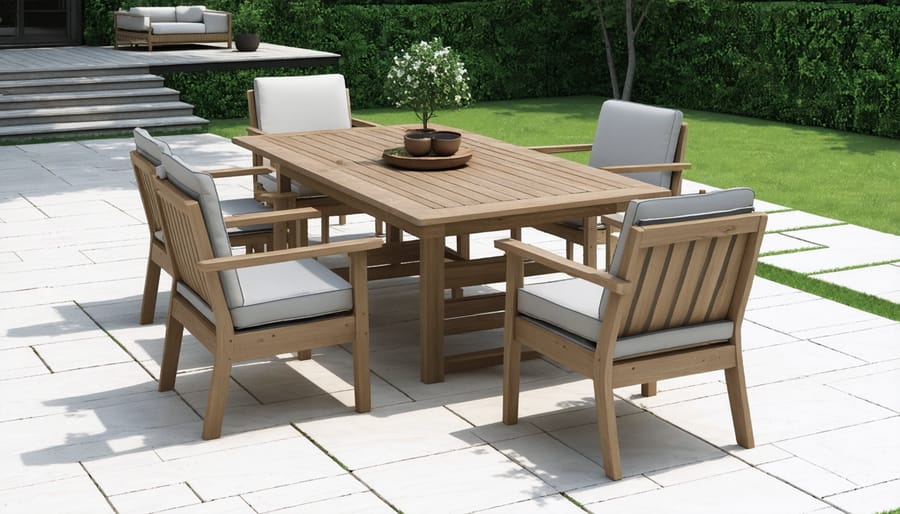
Building your own 4×4 outdoor furniture not only creates beautiful, durable pieces for your outdoor space but also contributes to sustainable living. To ensure your handcrafted furniture stands the test of time, regular maintenance is essential. Apply a fresh coat of weather-resistant sealant annually, and inspect joints and fasteners each season. Store cushions indoors during harsh weather, and clean surfaces regularly with mild soap and water to prevent mold growth.
From an environmental perspective, crafting furniture from 4×4 lumber is an eco-conscious choice. By selecting locally sourced, pressure-treated lumber or naturally resistant woods like cedar, you’re reducing transportation emissions and supporting sustainable forestry practices. These DIY projects can be part of broader backyard transformation ideas that enhance both your living space and environmental stewardship.
Remember, well-maintained outdoor furniture can last for decades, reducing the need for replacement and minimizing waste. By following these plans and maintenance guidelines, you’re not just creating beautiful outdoor pieces – you’re making a lasting investment in both your home and the environment.

